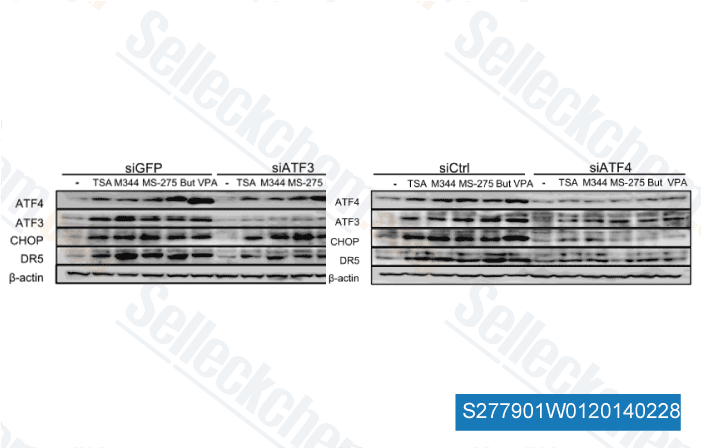|
Toll Free: (877) 796-6397 -- USA and Canada only -- |
Fax: +1-832-582-8590 Orders: +1-832-582-8158 |
Tech Support: +1-832-582-8158 Ext:3 Please provide your Order Number in the email. |
Technical Data
| Formula | C16H25N3O3 |
||||||||||||||
| Molecular Weight | 307.39 | CAS No. | 251456-60-7 | ||||||||||||
| Solubility (25°C)* | In vitro | DMSO | 62 mg/mL (201.69 mM) | ||||||||||||
| Ethanol | 4 mg/mL (13.01 mM) | ||||||||||||||
| Water | Insoluble | ||||||||||||||
| In vivo (Add solvents to the product individually and in order) |
|
||||||||||||||
|
* <1 mg/ml means slightly soluble or insoluble. * Please note that Selleck tests the solubility of all compounds in-house, and the actual solubility may differ slightly from published values. This is normal and is due to slight batch-to-batch variations. * Room temperature shipping (Stability testing shows this product can be shipped without any cooling measures.) |
|||||||||||||||
Preparing Stock Solutions
Biological Activity
| Description | M344 is a potent HDAC inhibitor with IC50 of 100 nM and able to induce cell differentiation. | ||
|---|---|---|---|
| Targets |
|
||
| In vitro | M344 produces a more significant effect on cell proliferation than on cell differentiation in MEL DS19 cells. This compound is toxic at concentrations above 10 μM, while a maximum of only 20% of the surviving cell population are induced to differentiate. [1] In vitro, this chemical shows the significant anti-proliferative activities against the endometrial cancer cell line Ishikawa and the ovarian cancer cell line SK-OV-3 with EC50 of 2.3 μM and 5.1 μM, respectively. While the normal human endometrial epithelial cells shows little sensitivity to this compound. In addition, it also leads to decreased proportion of cells in the S-phase and increased proportion in the G0/G1 phases of the cell cycle, induces apoptosis and decreases the transmembrane potential of mitochondria. [2] This chemical potently inhibits proliferation of embryonal nervous system tumor cells including medulloblastoma cells (D341 Med, Daoy) and neuroblastoma cells (CH-LA 90,SHSY-5Y ) with GI50 of 0.65 μM, 0.63 μM, 0.63 μM and 0.67 μM, respectively. [3] |
||
| Features | An inducer of terminal cell differentiation and a potent HDAC inhibitor. |
Protocol (from reference)
| Kinase Assay: |
|
|---|---|
| Cell Assay: |
|
References
|
Customer Product Validation

-
Data from [ Biochem Biophys Res Commun , 2014 , 445(2), 320-6 ]
Selleck's M344 (D 237) Has Been Cited by 13 Publications
| M344 Suppresses Histone Deacetylase-Associated Phenotypes and Tumor Growth in Neuroblastoma [ Int J Mol Sci, 2025, 26(17)8494] | PubMed: 40943415 |
| Development of a high-throughput platform for quantitation of histone modifications on a new QTOF instrument [ Mol Cell Proteomics, 2024, S1535-9476(24)00187-7] | PubMed: 39708910 |
| Targeting codon 158 p53-mutant cancers via the induction of p53 acetylation. [ Nat Commun, 2020, 29;11(1):2086] | PubMed: 32350249 |
| Quantifying Drug Combination Synergy along Potency and Efficacy Axes. [ Cell Syst, 2019, 8(2):97-108] | PubMed: 30797775 |
| Inhibition of HDAC4 Attenuated JNK/c-Jun-Dependent Neuronal Apoptosis and Early Brain Injury Following Subarachnoid Hemorrhage by Transcriptionally Suppressing MKK7. [ Front Cell Neurosci, 2019, 13:468] | PubMed: 31708743 |
| DRUGPATH - a novel bioinformatic approach identifies DNA-damage pathway as a regulator of size maintenance in human ESCs and iPSCs [ Sci Rep, 2019, 9(1):1897] | PubMed: 30760778 |
| Neutralizing negative epigenetic regulation by HDAC5 enhances human haematopoietic stem cell homing and engraftment. [ Nat Commun, 2018, 9(1):2741] | PubMed: 30013077 |
| Epigenetic Reprogramming with Antisense Oligonucleotides Enhances the Effectiveness of Androgen Receptor Inhibition in Castration-Resistant Prostate Cancer [ Cancer Res, 2018, 78(20):5731-5740] | PubMed: 30135193 |
| Evaluating biological activity of compounds by transcription factor activity profiling. [ Sci Adv, 2018, 4(9):eaar4666] | PubMed: 30263952 |
| Histone deacetylase inhibitor M344 significantly improves nuclear reprogramming, blastocyst quality, and in vitro developmental capacity of cloned pig embryos [ J Anim Sci, 2017, 95(3):1388-1395] | PubMed: 28380503 |
RETURN POLICY
Selleck Chemical’s Unconditional Return Policy ensures a smooth online shopping experience for our customers. If you are in any way unsatisfied with your purchase, you may return any item(s) within 7 days of receiving it. In the event of product quality issues, either protocol related or product related problems, you may return any item(s) within 365 days from the original purchase date. Please follow the instructions below when returning products.
SHIPPING AND STORAGE
Selleck products are transported at room temperature. If you receive the product at room temperature, please rest assured, the Selleck Quality Inspection Department has conducted experiments to verify that the normal temperature placement of one month will not affect the biological activity of powder products. After collecting, please store the product according to the requirements described in the datasheet. Most Selleck products are stable under the recommended conditions.
NOT FOR HUMAN, VETERINARY DIAGNOSTIC OR THERAPEUTIC USE.
